Hiking Alone in Bear Country: Bear Safety Tips
Are you a beginner hiker eager to hit the trails? Or maybe a more seasoned outdoor enthusiast who spends a lot of time in bear country. With proper awareness, you can safely enjoy the great outdoors while minimizing the risks associated with hiking alone in bear country.
I have spent over 10 years hiking solo in the Canadian Rockies. Was it always the smartest? Probably not…but I made sure to be properly prepared and in all my years of hiking I have never encountered a bear while hiking. Luck must be on my side!
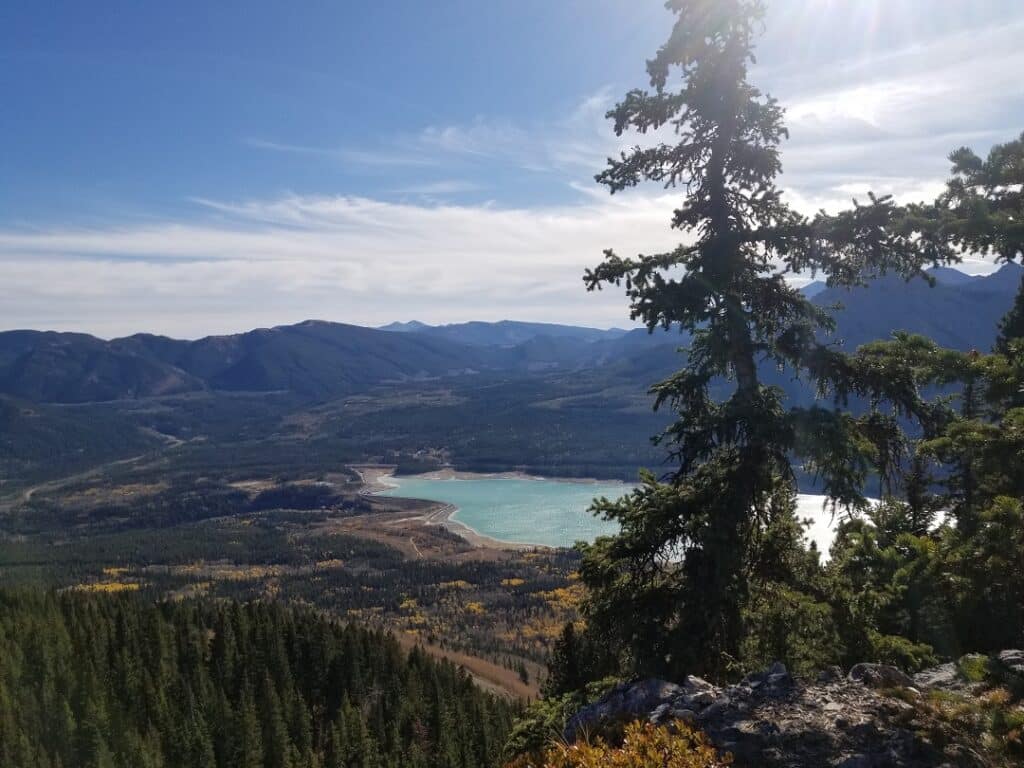
Whether you are hiking in the Canadian Rockies, Yellowstone National Park , or any of the national parks, there’s a good chance that you may encounter black bears or grizzly bears. It can happen unexpectedly. However this shouldn’t deter you from getting outdoors and connecting with nature. With the right knowledge, you can be prepared.
You can encounter bears on busy trails, backcountry or in a town. I remember years ago a black bear wandered into a restaurant in the town of Canmore, so you just never know where they may be. Generally bears tend to avoid interacting with people, but often are drawn towards sources of food.
Disclaimer: This post may include affiliate links. If you click one of them, I may receive a small commission at no extra cost to you.
Bear Safety Tips While Hiking:
Carry Bear Spray
Bear Spray is a deterrent that is used to stop threatening, charging, or attacking bears. It contains capsaicin which is found in chili peppers. When sprayed, the pepper spray can reach a distance of 10m and was found to be 98% effective at stopping bear attacks when used properly (Smith et al. 2008). It will sting a bear’s eyes and cause some difficulty in breathing, but will not harm the bear long term.
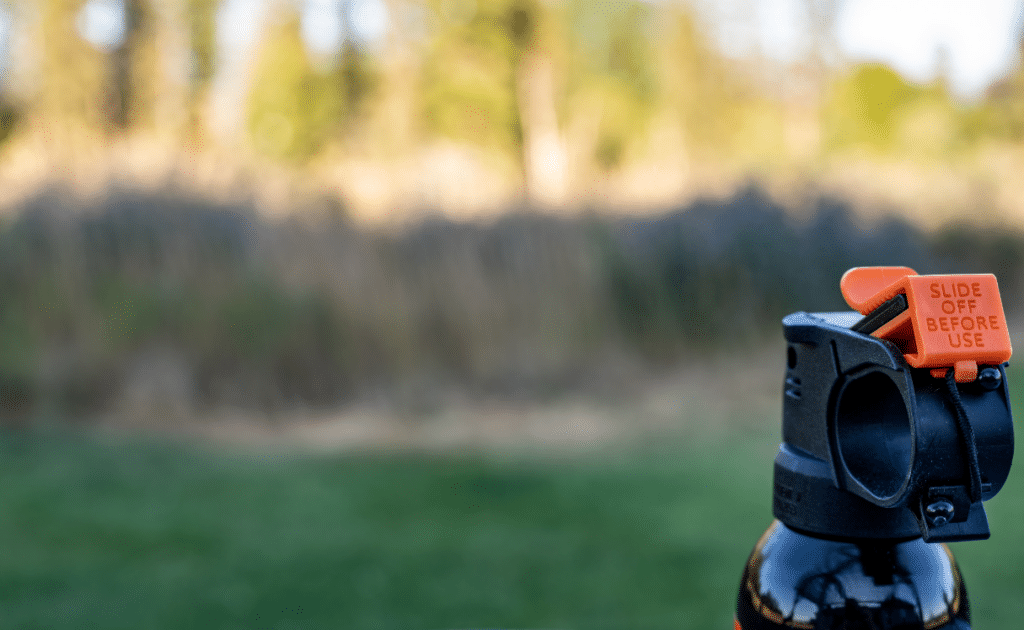
US: Bear spray can be purchased at most outdoor stores like REI.
Canada: Bear Spray must be purchased at an outdoor store like MEC and you are required to show ID and fill out a form, as it is under federal regulation. It is illegal to carry bear spray other than being used outdoors for animal protection.
Ensure that your bear spray is easily accessible and is usually best to be worn around your waist. I recommend using this Bear Spray Waist Belt.
Ensure that you know how to use bear spray correctly.
If you are hiking in a group, EVERY person should have their own bear spray.
Be Aware of Your Surroundings
Be attentive and pay attention to what is around you while hiking. Keep an eye out for signs of bear activity like tracks, scat, diggings, scratches on trees or overturned rocks. If you come across a large carcass, leave the area immediately. It is recommended not to wear ear buds, as this impedes the ability to hear what is going on around you.
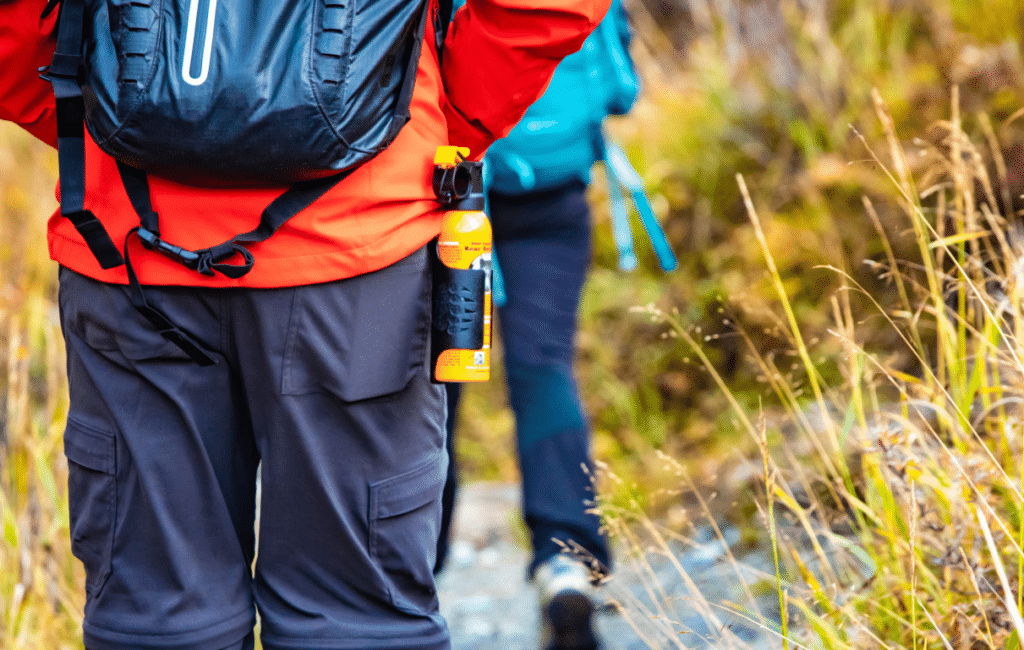
Make Noise
Solo hikers are more likely to surprise bears, since they are quiet. The most effective thing to do is to talk or sing out loud. When I was hiking alone in Jasper National Park I talked to my dog a lot! I have a whistle that I will blow every couple of minutes. Osprey daypacks have built-in whistles on the straps that sit right on your chest, making them easy to access.
Some people believe that using bear bells will be effective. There was a study done by Dr. Tom Smith on the efficacy of bear bells, and he found the bears did not react to the sound of the bells whatsoever. The bears did react to the human voice and sounds of branches breaking (which are sounds bears recognize to be threatening).
Some people think that playing anything out loud like music or a podcast on a speaker may not work well. The sound doesn’t carry as well as your voice if you let out some yells, it is hard to hear things happening around you and it can be rude to fellow hikers.
Avoid Peak Times
Avoid hiking at dawn or dusk when bears are more active. You can encounter them at any time of the day, but you will often have more people on the trails during the daytime. Make sure you also stay on the marked trails.
Keep Your Dog On Leash
You may have the best, well trained dog, but if your dog is off leash, there is always a possibility that they can come across a bear and start barking. That bear may become defensive, react and your dog may come running back towards you, being followed by a bear. A study on non-fatal black bear attacks showed that 40% of defensive attacks by female black bears involved dogs (Scharhag et al. 2021).
Most national or state parks do not allow for dogs to be off leash, or they may not even allow dogs to be in the park. Make sure you check your park rules.

HIke in Groups
Even though you may enjoy hiking solo, it is recommended to hike in groups of at least 4 people to ensure safety. I often do not hike solo during the summer months as the bears are often more active and I want to be bear aware. There are some trails that do not allow for hiking with groups less than 4 people, so do your research ahead of time.
Check for Bear Sightings
National Park Service in the US and Parks Canada in Canada have links to the national parks, where you can check for bear sightings. Ensure you check the websites for the park and trails you will be visiting, as sometimes the trails will be closed if there is a lot of bear activity. It is a good idea to avoid an area with bear warnings and choose another trail to give these animals their space, especially if solo hiking.
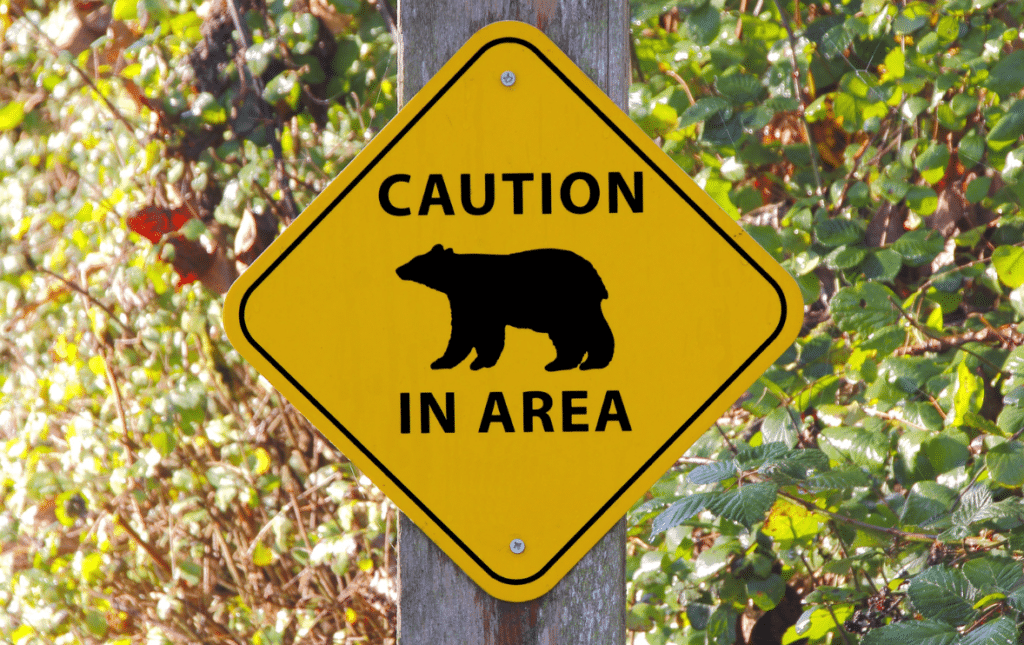
What Should You Do If You See a Bear While Hiking?
It depends on the scenario and behaviour the bear is showing. Always remain calm, take out your bear spray, get the safety off, and NEVER run.
Bear Is Far Away: If the bear is far off in the distance and unaware of your presence, it’s best to leave the area, make your way back to the trailhead while being aware of your surroundings.
Bear is Walking Towards You: Bears will often use the same trails as us when moving from point A to B. You may see a bear walking towards you on a trail. What you’ll want to do is talk to the bear calmly, get your bear spray out, step off the trail while facing the bear and give it as much space as possible and a chance to pass by. If the bear leaves the trail and starts to follow you there’s a chance this bear is “predatory”. (see below for how to respond).
Bear Sees You As Prey: Predatory encounters are when a bear sees you as prey – they usually do not appear aggressive. They might be doing a zig zag pattern while following you with their head low. They will likely appear to be curious of you.
In this case, you need to show the bear you are not prey. Stand your ground, act big, speak loud and firm, group up, wave your arms around, etc. If you have an air horn, use it. If the bear does not leave, you’ll spray it. If the bear makes contact, you’ll fight with rocks, sticks, etc.
Note: This type of behaviour is usually from black bears more often than grizzlies, but predatory attacks are quite rare regardless of the species.
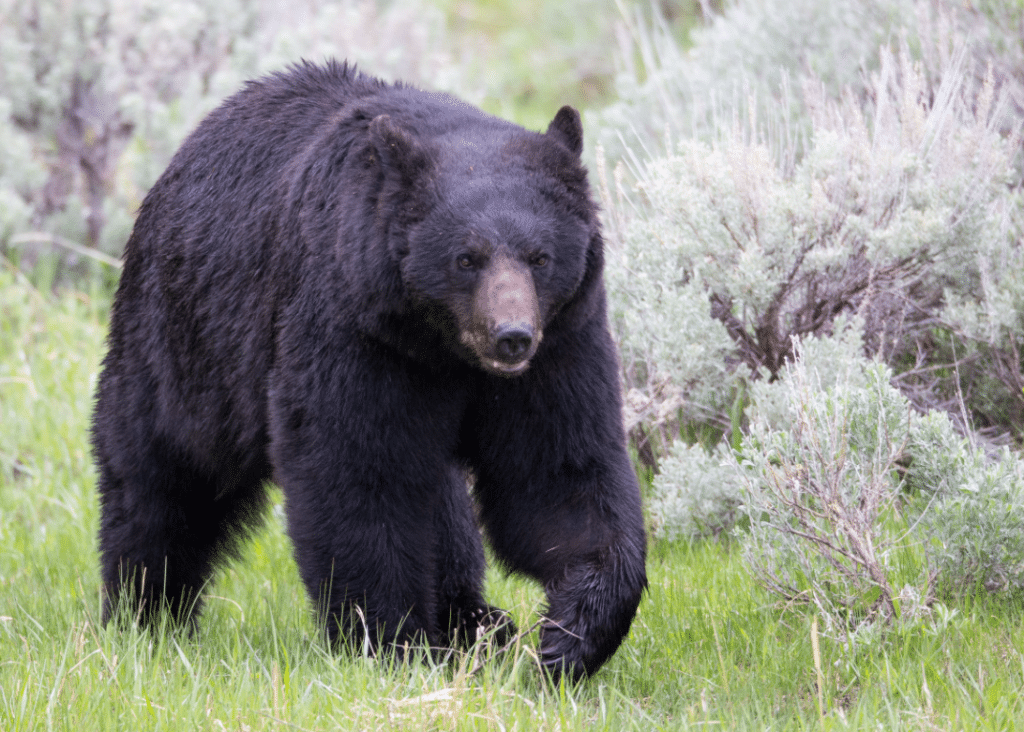
What If A Bear Attacks?
Defensive encounters usually occur when you surprise a bear at close range. The bear may have cubs or a food source that it is protective of. In this case, the bear will appear very agitated. The bear will be huffing, jaw popping, bluff charging, etc. You need to show this bear you are not a threat by backing away slowly, talking quietly and calmly.
Spray if the bear charges you. If the bear makes contact, play dead. Lay on your stomach with legs spread, hands on the back of your neck. If the attack continues after a couple minutes, there is a chance this attack has now turned predatory. Now you will fight back. The vast majority of grizzly bear attacks are defensive in nature. Black bears can also be defensive though, which is why it’s so important to look at the behaviour rather than the species and respond accordingly.
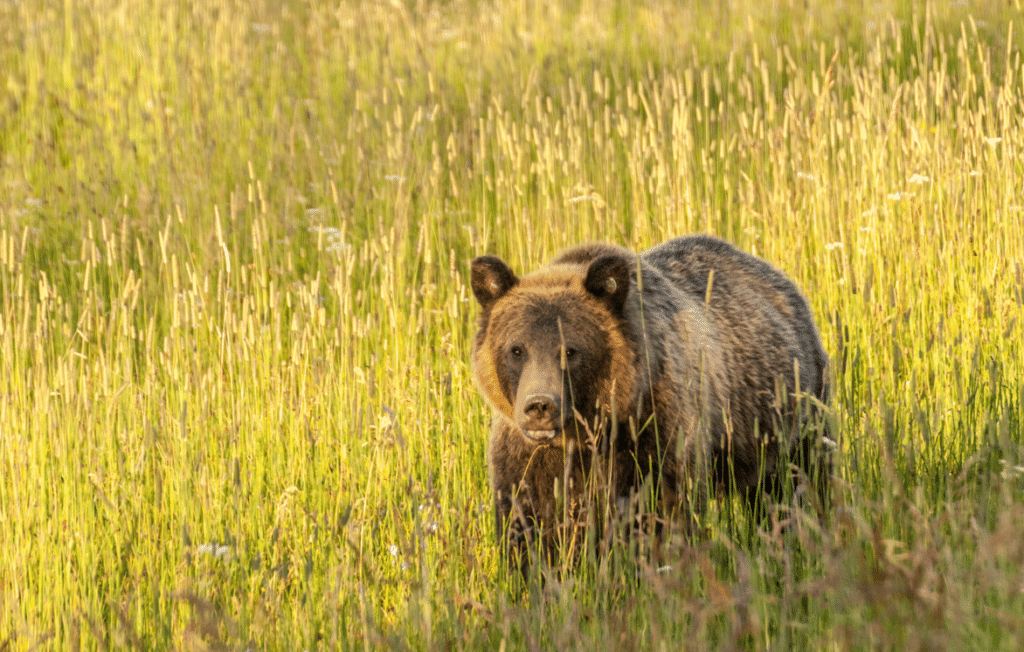
Do I Need to Worry About Bears In The Winter?
Hiking in the winter months is generally safer as bears are hibernating, so your chances of running into one are low. However, it is always possible. Carrying bear spray when hiking alone in bear country can be useful if you run into another animal like a cougar.
Where Can I Learn About Bear Safety?
Learning about bear behavior and knowing what to do in the event of a bear encounter is something every person should do. Bear Safety & More provide courses for everyone including businesses. Follow them on social media @bearsafetyandmore to stay up to date on tips, upcoming free courses and information about bear safety. Thank you to Bear Safety & More for providing valuable information in this article.
Can I Hike Alone in Bear Country?
Yes, you can hike alone in bear country, but it is essential to understand the risks and to take all the necessary precautions. Solo hiking offers a unique sense of freedom and adventure, but it also requires awareness and preparation.
What Should I Have For Hiking?
It is essential to know and follow hiking safety tips to ensure you are prepared and safe while exploring. You can also download our FREE hiking checklist to ensure you have everything you need for a successful outdoor hiking adventure.
Final Thoughts
In conclusion, hiking alone in bear country can be a thrilling and rewarding experience, but it’s essential to prioritize safety. By following these bear safety tips and remaining aware while on the trails, you can enjoy the beauty of nature while minimizing the risks. I have hiked for years alone and it is definitely doable with the right knowledge and gear.
If you enjoyed my post, follow me on social media or subscribe to my newsletter below, so you can stay connected on future posts, trips, tips and more.



Great tips! I have not heard of bear bells before. It’s so interesting that the bears didn’t even respond when they heard them. Thank you for sharing your knowledge.